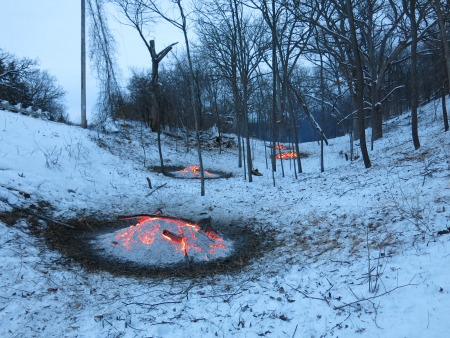Volunteers Complete First Step in Restoration

Landowners quickly learn that restoration is not a task, nor an event; it is a process. The older among us can remember a childhood when open woodlands were the rule across rather than the exception. Spring brought a riot of ephemeral wildflower carpeting the forest floor with native lady slipper orchids, columbine, and Dutchman’s britches. Competing with them were woodland geraniums, Mayapples, Jack-in-the-pulpet. Later in the year, those early inhabitants would yield to bottlebrush grass, bergamot, Canada wild rye, black-eyed Susan and woodland tree tic foil. Areas that saw less grazing, the woodland floor would include a much wider array of grasses, legumes, and wildflowers.
Before Europeans settled Wisconsin, much of the southern and western regions covered by prairies and savanna, where woodlands were mostly confined to ravines and lowland floodplains. Teacher told me in school that lighting caused wildfires. While every year, lightning strikes did ignite wildland fires across our prairies and savannas. Fire was the management tool of choice for Native Americans. They used it to maintain high quality forage for buffalo, deer and elk. At the same time, our predecessors left unburned patches in an ever changing mosaic that provided them with patches where they could harvest berries, chokecherries, hazelnuts and other valuable foodstuffs. What we now call “cultural fire” was their method or choice to maximize the yields from their Wisconsin home.
The Process
A year ago, this shallow ravine was clogged with invasive shrubs so dense that it would have been nearly impossible to see 1oo feet into the woodland. Moreover, almost nothing would have been able to grow underneath that massive over of shrubs. Hence, there was little in the way of grasses or forbs (wildflowers) growing. Under normal conditions, this area you see in this picture could not possibly carry fire, neither prescribed fire not wildfire. There would simply be too little fuel in the dormant season. A well, the high moisture conditions once the shrubs were leafed out would make this ravine what has become known as an “asbestos forest.”
Restoration is more than clearing invasive honeysuckle and buckthorn. It is an entire series of conservation practices that help the land heal itself. Once cleared, sunlight can once again reach the soil. It provides the warmth and energy needed for grasses and wildflower to thrive. Unfortunately, it also provides perfect growing conditions for annual weeds and invasive herbaceous plants like garlic mustard and orange hawkweed. This land will need to be seeded with native species. Just as important, mowing high several times a season for the next two years will protect those new seedlings from re-invasion. In some cases, it may be necessary to supplement this mowing with spot treatment with herbicide, as well.
In two or three years, this ravine will be ready for its first prescribed burn. Enough native grasses and wildflowers will be available to provide a relatively continuous source of fuel for the low intensity fire. Prescribed fire prevents invasive shrubs and most seedlings from becoming established. Repeated prescribed fires every one to three years will further open the canopy as storms and disease further cull woodland. As the conditions improve, a wider variety of native plant species will return. Along with them an amazing number and variety of insects, birds and even mammals.
Making a Difference
Volunteers help press the reset button on a natural community that provides incredible abundance because it regularly receives sees active human intervention. And that is, after all, the essence of land stewardship.
The Wisconsin DNR owns and manages this parcel in the Southern Kettle Moraine . Volunteers who understand the value of restoration performed the clearing and brush pile burning. They are part of the DNR State Natural Area Volunteer Program. Some of them will use the knowledge and skills they gain helping our public lands, to make similar progress on their own land.
